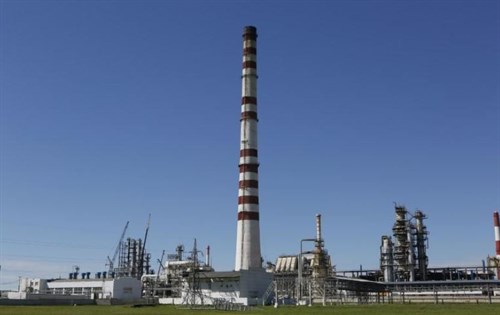Exxon pushes ahead with Rosneft LNG project despite sanctions
BEIJING/LONDON (Reuters) - Exxon Mobil (XOM.N) is pushing ahead with efforts to develop its $15 billion Far East Liquefied Natural Gas (LNG) project with Russia’s Rosneft (ROSN.MM) despite being forced to exit some joint ventures due to Western sanctions.
 |
| Achinsk oil refining factory, owned by Rosneft company, outside the town of Achinsk in Krasnoyarsk region, Russia June 5, 2017. (IMAGE SOURCE: REUTERS/Ilya Naymushin) |
Two months ago Exxon invited companies including China National Petroleum Corporation’s [CNPET.UL] engineering arm to bid for construction contracts by October, sources with knowledge of the matter said.
A final investment decision is due in 2019, they said.
The project is being jointly developed with Rosneft using gas from the Sakhalin-1 venture which will be chilled into liquid to underpin the LNG plant’s initial annual output target of 6 million tonnes.
Western sanctions forced Exxon to exit some joint ventures with Rosneft in late February, but LNG is not part of the sanctions. The Russian company said the move would not affect the Sakhalin-1 oil and gas production-sharing JV struck in the mid-1990s.
“A liquefied natural gas plant is an option to maximize benefits to the consortium and the Russian state and its citizens,” she added.
Exxon-Rosneft have also held discussions about feeding gas from Sakhalin-1 fields into a planned third production unit at an existing LNG plant run by Gazprom (GAZP.MM) on Sakhalin Island, industry sources said.
Exxon’s LNG footprint is expanding rapidly with major new projects planned in Qatar, Mozambique, Papua New Guinea and the United States as demand in China and Southeast Asia booms.
Gas accounted for 43 percent of Exxon output last year, according to BMO Capital Markets, a share set to rise as new LNG projects start up.
CHINESE UP LNG PROJECT WORK
CNPC’s Huanqiu Contracting & Engineering Corp is preparing to bid for engineering, procurement and construction (EPC) contracts for Far East LNG’s supporting facilities, such as storage tanks, pipelines and utilities, a source with direct knowledge of the matter said.
Chinese engineering companies, banks and shipyards are all muscling into LNG, typically the preserve of Western, Japanese and South Korean players, as government coal-to-gas switching policies make LNG an increasingly strategic fuel.
For example, Chinese investment is pouring into African floating LNG projects, import terminals, tankers and traditional land-based plants such as the $12 billion invested in Russia’s Yamal facility, used to skirt Western sanctions.
Loans in turn drum up business for Chinese engineering firms and shipyards in LNG, and give state-backed companies the upper hand in supply negotiations.
It is unclear if Chinese lenders will help finance Far East LNG.
The bid deadline for EPC contractors is September 30, sources said.
JGC was not available for immediate comment and Fluor declined to comment.
Writing by Oleg Vukmanovic, additional reporting by Vladimir Soldatkin in Moscow and Ron Bousso in London, editing by Veronica Brown and Jason Neely

- ExxonMobil halts 1-Bft3d blue hydrogen project in Texas
- Aramco and Yokogawa commission multiple autonomous control AI agents at Fadhili gas plant
- Ukraine will resume gas imports via Transbalkan route in November
- Mitsubishi to inject $260 MM into Brunei LNG project
- Freeport LNG (U.S.) on track to take in more natgas on Thursday after unit outage



Comments